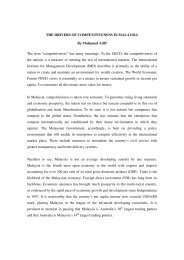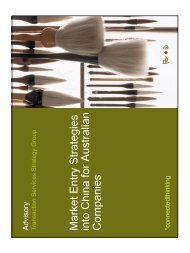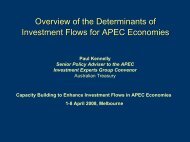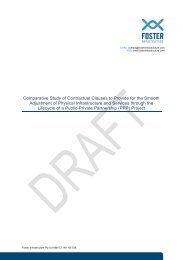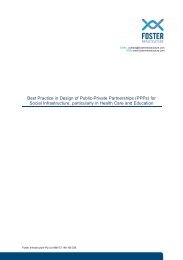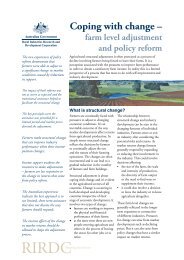The Challenge of Trade Liberalisation - Australian APEC Study Centre
The Challenge of Trade Liberalisation - Australian APEC Study Centre
The Challenge of Trade Liberalisation - Australian APEC Study Centre
- No tags were found...
Create successful ePaper yourself
Turn your PDF publications into a flip-book with our unique Google optimized e-Paper software.
<strong>The</strong> <strong>Challenge</strong> <strong>of</strong> <strong>Trade</strong><strong>Liberalisation</strong>Christis.Tombazos@BusEco.monash.edu.auhttp://www-personal.buseco.monash.edu.au/~tombazos/1
Outline <strong>of</strong> Discussion• Part 1: Gains from <strong>Trade</strong> and the <strong>Challenge</strong> <strong>of</strong> <strong>Liberalisation</strong> Why trade? Sources <strong>of</strong> comparative advantage Optimality <strong>of</strong> free trade: self evident? <strong>The</strong> origin <strong>of</strong> tariffs (the quintessential tool <strong>of</strong> protection) <strong>The</strong> menu <strong>of</strong> trade policies A microeconomic perspective <strong>of</strong> protection, its winners, and losers A broader view <strong>of</strong> the benefits <strong>of</strong> liberalisation <strong>The</strong> costs <strong>of</strong> liberalisation• Part 2: Advanced Issues in <strong>Trade</strong> <strong>Liberalisation</strong> Unilateral reform: Piecemeal or “Shock” Multilateral reform: Types <strong>of</strong> agreements and reform commitments Multilateral vs. unilateral reform: what to choose? <strong>The</strong> measured effectiveness <strong>of</strong> liberalisation efforts2
Part 1: Gains from <strong>Trade</strong> and the<strong>Challenge</strong> <strong>of</strong> <strong>Liberalisation</strong>• Why trade?<strong>Trade</strong> prevails when:Foreign countries are able to supply goodsnot produced domestically……or, are able to supply goods (that are alsoproduced domestically) at a lower price thanthe price charged by domestic producers3
• Why is any country able to export any good at alower price than the importing country? Country X can export a good to country Y whenthe cost <strong>of</strong> production <strong>of</strong> this good in X is lowerthan that in Y• Sources <strong>of</strong> comparative advantage– (See Tombazos, Yang, Zhang, 2004) Technological differences (Ricardian model, circa 1816) Factor endowments (Heckscher-Ohlin, circa 1933) Economies <strong>of</strong> scale (New trade theory, circa 1980s?) Division on labour (Adam Smith, 1776)4
• Optimality <strong>of</strong> free trade: self evident? Whatever the reason for comparative advantage, If a foreign country is able to supply a good at a lower pricethan domestic producers …and trade is the natural decision <strong>of</strong> free agents, …and trade does not generate economic distortions, <strong>The</strong>n free trade must, by definition, maximise global welfare5
<strong>The</strong> origin <strong>of</strong> tariffs (the quintessential tool <strong>of</strong> protection) If trade is optimal, where do tariffs come from? Economic historians suggest that the first recordedinstances <strong>of</strong> the implementation <strong>of</strong> “modern tariffs”were motivated by efforts to raise revenues. <strong>The</strong>ircapacity to protect domestic industries was simplyviewed as a side-effect. Furthermore, reliance on tariffs to raise revenueappears to relate to the notion that it is easier to“control” borders than households For example, the US relied on tariffs as the only source<strong>of</strong> (transferable) revenue until income taxes becameconstitutional with the 16 th Amendment in 19136
In general, use <strong>of</strong> tariffs (and other trade barriers)during the 20 th century did not target raisingrevenue, but protecting domestic industries fromforeign competition Tariffs and other trade barriers remain widespreadbecause• Effective tools <strong>of</strong> protection (refer to the politicaleconomy topic that will be addressed by other speakers)7
• Unlike “comparable” schemes (such as productionsubsidies) trade barriers do not require “visible”transfers, hence their harmful effects are not readilydetectable (and segments <strong>of</strong> society disadvantagedfrom tariffs do not oppose them as vociferously aswarranted)• Can be easily misdiagnosed as “legitimate” policythat promotes a variety <strong>of</strong> economic objectives:– economy-wide employment,– Protection <strong>of</strong> “infant” industries,– economic development and growth, etc.8
• <strong>The</strong> menu <strong>of</strong> trade policies Tariffs Ad Valorem: <strong>The</strong> rate <strong>of</strong> import duty is expressed as apercentage <strong>of</strong> the price <strong>of</strong> the importable (e.g. 36%) Specific: <strong>The</strong> import tax is expressed in terms <strong>of</strong> anominal amount per unit <strong>of</strong> output (e.g. $20 per unit) Quotas Volume: A restriction on the quantity <strong>of</strong> imports <strong>of</strong> aparticular category Value: A restriction on the total value <strong>of</strong> imports <strong>of</strong> aparticular category Tariff-Quotas A specified quantity is permitted to enter at a givenrate <strong>of</strong> duty or duty-free. Any additional quantity thatmay be imported is subjected to a higher duty9
Other Non-Tariff Barriers Governments apply many regulations to importswith respect to• Safety• Health• Labelling• Packaging• And Technical standardsAlthough occasionally desirable on social grounds,such regulations <strong>of</strong>ten discriminate against importswithout justification by imposing higher standardson foreign producers than on their domesticcompetitors10
• A microeconomic perspective <strong>of</strong> protection, itswinners, and losers Preliminary concepts: Consumer surplus (CS): <strong>The</strong> benefit that accrues toconsumers from economic transactions Producer surplus (PS): <strong>The</strong> difference betweenrevenue (R) and variable cost (VC). This is very similarto, indeed a reflection <strong>of</strong>, “Pr<strong>of</strong>it”. (Pr<strong>of</strong>it=R-VC-FC) See interactive animation outlining the impact <strong>of</strong>tariffs on Consumer Surplus, Producer Surplus,Government Revenue (GR), and Deadweight Loss(DWL)11
An eloquent summary <strong>of</strong> these results was provided asearly as 1927 by J. B. Brigden who chaired a committee<strong>of</strong> five economists appointed by <strong>Australian</strong> Prime MinisterS. M. Bruce to “inquire into the effects <strong>of</strong> the tariff”.<strong>The</strong> report by Brigden (Economic Record, 1927, pg. 29)read:“<strong>The</strong> protection <strong>of</strong> manufacturers and <strong>of</strong> labour marches inone indissoluble unity, and in this manner, at least, thetwo lions <strong>of</strong> employer and employee lie down in the samefeast with the same “lamb”………. … consuming the consumer”12
• A broader view <strong>of</strong> the benefits <strong>of</strong> liberalisation<strong>Trade</strong> liberalisation facilitates: Efficient “in country” allocation <strong>of</strong> resources Resources are invested in those activities that are most highlyvalued by the market Enhanced efficiency in the global organisation <strong>of</strong>production and international exchange made possible byexploitation <strong>of</strong> comparative advantage (World-wide output<strong>of</strong> all commodities expands) In “tangible” terms:• Imports become cheaper – hence, welfare <strong>of</strong> domesticconsumers increases• Exporters have better access to foreign markets – hence,greater pr<strong>of</strong>its13
In addition to the usual (exogenous) sources <strong>of</strong> comparativeadvantage, free trade promotes:• Exploitation <strong>of</strong> economies <strong>of</strong> scale• Economies <strong>of</strong> specialisation resulting from division <strong>of</strong> labour (X.Yang, 1994) Greater variety <strong>of</strong> commodities hence greater social welfare(See “love <strong>of</strong> variety” models such as Krugman, 1980) Greater international competition leading to greater incentivesto become more efficient by: Adopting new technologies, new entrepreneurial frameworks, andnew distribution models• …leading to “export-led growth” (Feder, 1983) Even in the case <strong>of</strong> pre-liberalisation “small countries” –liberalisation may bring about an improved internationalbargaining position, leading to better terms <strong>of</strong> trade14
• <strong>The</strong> costs <strong>of</strong> liberalisationA. Industry adjustment effects Such effects concentrate on the transfer <strong>of</strong>resources from the production <strong>of</strong> importablesto the production <strong>of</strong> exportables (seesimulation) Decrease in the size <strong>of</strong> the import competing sector(decrease in output, employment, number <strong>of</strong>firms/farms) Expansion <strong>of</strong> the export oriented sector (increasein output, employment, number <strong>of</strong> firms/farms)15
It is important to note that industry adjustment Is not instantaneous – may lead to significant levels<strong>of</strong> short term unemployment, and significantdisruption in the economy• For an example, the 1973 25% across-the-board tariffreduction in the <strong>Australian</strong> TCF sector coupled withelimination <strong>of</strong> quotas on imported knitwear and wovenshirts (other relevant events coincided: appreciation <strong>of</strong> the$, equal pay legislation, etc.) led to a significant decrease inemployment:– From March 1974 to March 1975 employment in theTCF sector fell by almost 25%, or 34,000 jobs!16
Of course, the hardship <strong>of</strong> industry adjustmentshould not discourage governments from followingthrough with liberalisation initiatives that willunambiguously lead to beneficial long termoutcomes• Going back to the TCF example, the <strong>Australian</strong>governments <strong>of</strong> the 1970s were not prepared to deal withthe fallout– Whitlam gvt. negotiated VERs with major textileexporting nations under the MFA <strong>of</strong> the GATT– In early 1975 the gvt. replaced the VERs with tariffquotas– <strong>The</strong> above measures were deemed insufficient by theincoming Fraser gvt. that in 1977 replaced tariff-quotaswith considerably more distortionary volume quotas17
Industry adjustment may requireconsiderable retraining <strong>of</strong> workers that aretransferred across sectors <strong>of</strong> the economy inconjunction with the provision <strong>of</strong> assistanceto these workers• Hence, there is scope for short termgovernment policies that can assist thetransition–But these need to be short termpolicies otherwise liberalisation wouldsimply entail replacing one set <strong>of</strong>distortions with another18
• Going back to the TCF example,In response to the vast lay <strong>of</strong>fs caused bythe 25% tariff cut the <strong>Australian</strong> gvt.Introduced a scheme <strong>of</strong> “StructuralAdjustment Assistance” that provided:–Compensation, subsidies, andemployment maintenance to assistemployees, firms and regions affectedby the cuts19
B. Structural implications Infant industry argument (Krueger, 1982) Import Substitution Industrialisation (Schultz, 1964) Employment – last stronghold <strong>of</strong> liberalisation sceptics <strong>The</strong>re is the presumption (even by many free traders!) thatimports displace demand for domestic labour In Australia, this has translated into concerns that imports fromthe low-wage neighbouring countries <strong>of</strong> East Asia lead tounemployment Well known contributions in this area that find “evidence” insupport <strong>of</strong> these suspicions include:• Gregory, Anstie, and Klug (NBER, 1991)• Fahrer and Pease (PCP, 1994)20
Such studies rely on the well known assumption <strong>of</strong> positivetrade theory that traded goods are “final”Hence, importsa. displace domestic labour that would otherwise be employed inimport competing sectorsb. And have no other effect on employment in other sectors <strong>of</strong>the economyBut this is wrong. All imports (including those <strong>of</strong>, so called,“final goods”) are intermediate in nature and a significantportion <strong>of</strong> their shelf price reflects value added domesticallyAnd this is an important point as intermediate importssubject to downstream production processes that arecomplementary with domestic labour have the potential tostimulate demand for labour (most likely in sectors otherthan the import competing sector itself).21
In (Econ. Letters, 1999) I investigate this hypothesis I find that an increase in imports from Asian countriesinto Australia (holding exports fixed) increase overalldemand for <strong>Australian</strong> labour!22
Part 2: Advanced Issues in <strong>Trade</strong><strong>Liberalisation</strong>• Unilateral reform: Piecemeal or “Shock” In the case <strong>of</strong> a “small” economy, a “shock” approachthat entails elimination <strong>of</strong> all distortions (tariffs, quotas,etc.) will establish the optimum result However, in an effort to ameliorate the <strong>of</strong>ten significantindustry adjustment effects <strong>of</strong> the shock approach, apiecemeal initiative that entails a sequence <strong>of</strong> smalltrade barrier reductions (eventually leading tocomplete liberalisation) may be adopted23
Piecemeal liberalisation can be exceptionallycomplex, and individual liberalisation “steps”may lead to decreases in welfare. Consider for example the case <strong>of</strong> twoimportables, say X and Y, that are substitutes. Adecrease in the tariff imposed on X:• Increases consumer surplus from X• Decreases the demand for Y, hence decreases tariffrevenues from imports <strong>of</strong> Y• It can be shown (see Vousden, 1991, p. 201-05) thatunder some circumstances the opposing effectsabove may lead to a net decrease in overall welfare24
In this light, the relevant rules <strong>of</strong> thumb (subjectto qualifications in Vousden, 1991, p. 205)require that:• More extreme distortions are reduced first• A good whose tariff is reduced has– Few substitutes with low tariff rates– Many complements with relatively high tariffs25
• Multilateral reform: Types <strong>of</strong> agreements and reformcommitmentsSchemeFreeintraschemetradeCommonexternaltradepolicyFreefactormobilityCommonmonetaryand fiscalpolicyOnegovernementFreetradeareaYesNoNoNoNoCustomUnionYesYesNoNoNoCommonMarketYesYesYesNoNoEconomicUnionYesYesYesYesNoPoliticalUnionYesYesYesYesYes26
• Multilateral vs. unilateral reform: what to choose? Consider the choice between comprehensive elimination <strong>of</strong> trade barriers, and the formation <strong>of</strong> a custom union In the following example we consider a commodity in whichthe exporting nation is not the least cost producer27
Whether the formation <strong>of</strong> a custom union improves welfaredepends on the relative size <strong>of</strong> the trade diversion andtrade creation effects Of course, the previous diagram does not consider thebenefits <strong>of</strong> multilateral agreements that derive fromincreased exports However, given sufficient trade diversion effects, there isno guarantee that multilateral agreements will generatesuperior outcomes to unilateral liberalisation initiatives. Given the questionable benefit <strong>of</strong> custom unions, there is astrong argument to be made for aggressive unilateralliberalisation initiatives Incurring the distortions <strong>of</strong> trade barriers in the hope that, intime, other countries may agree to multilateral liberalisationefforts (that may, or may not, be superior to unilateralinitiatives) is a policy <strong>of</strong> questionable merit29
• <strong>The</strong> measured effectiveness <strong>of</strong> liberalisation efforts Studies that investigate the effectiveness <strong>of</strong>liberalisation initiativesUtilise models that capture the “reaction” thatflows from tariffs to importsSuch studies find a remarkably small effect• For an extreme example, consider Simmonsand Smith (1994) who determine that, at least inrelation to the examined manufacturing sector,“…removal <strong>of</strong> the tariff would have no effect onthe level <strong>of</strong> imports…” (p. 57)30
Policy-makers are perplexed by such results In a recent paper (Southern Econ. Journal, 2003)I show that such results derive from a widespreadmisspecification <strong>of</strong> the adopted frameworks insuch research<strong>The</strong> flow <strong>of</strong> “reaction” is bi-directionalTariffsImportsIn this paper I show that when bothvariables are determined simultaneously theimpact <strong>of</strong> tariffs on imports doubles!31
Consider these results in the context <strong>of</strong>the 1970s dynamics pertaining to the<strong>Australian</strong> TCF sector25% 1973 across-the-board tariff cut ⇒imports increase ⇒job losses emerge ⇒political costs generated ⇒VERs, tariff-quotas, and then quotas introduced (i.e.protection resumes) ⇒imports decrease32
In short: <strong>Liberalisation</strong> initiatives can beeffective, as long as countries areprepared to handle the short termnegative industry adjustment effects inpursuit <strong>of</strong> the greater long term good33




